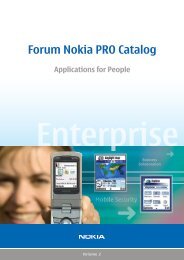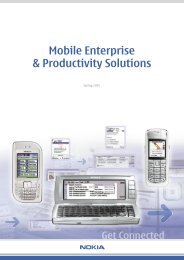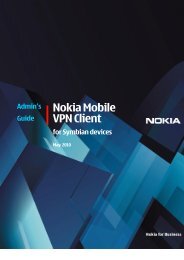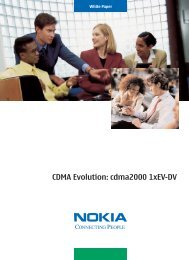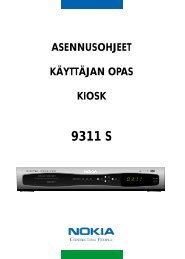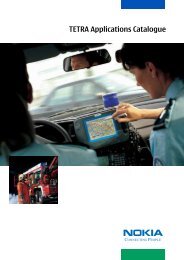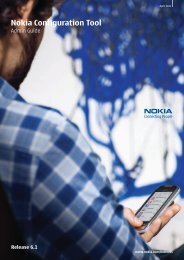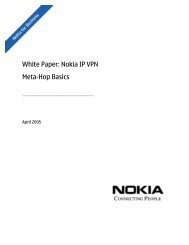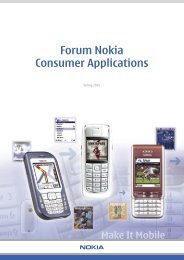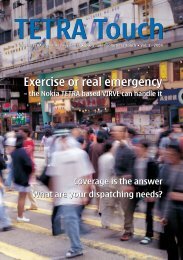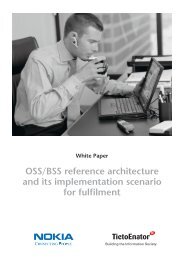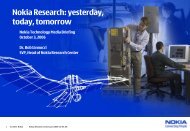Nokia Environmental Report 2002
Nokia Environmental Report 2002
Nokia Environmental Report 2002
You also want an ePaper? Increase the reach of your titles
YUMPU automatically turns print PDFs into web optimized ePapers that Google loves.
<strong>Environmental</strong> <strong>Report</strong> <strong>2002</strong><br />
B U S I N E S S G R O U P R E V I E W S<br />
<strong>Nokia</strong> Networks<br />
Our intent is to be an industry<br />
leader in environmental<br />
performance, making environmental<br />
affairs an integral and<br />
well-defined part of <strong>Nokia</strong><br />
Networks’ processes. Firstly, it<br />
is our intention to phase out<br />
restricted materials from our<br />
products by the end of 2005 as well as implement<br />
consistent global practices for the take back and recycling<br />
of obsolete electrical and electronic equipment<br />
from our customers.<br />
During <strong>2002</strong>, we continued to pursue focused environmental<br />
efforts in three core areas. This work is guided<br />
by our environmental intent, strategy and implementation<br />
plans.<br />
In the supplier interface we have trained around 300<br />
people in auditing and assuring supplier environmental<br />
compliance. In parallel, we have continued to communicate<br />
<strong>Nokia</strong> <strong>Environmental</strong> Supplier Requirements,<br />
particularly focusing on our 150 largest suppliers, and<br />
in our new purchasing agreements, we have clauses<br />
reflecting RoHS and WEEE directive requirements. In<br />
preparation, we have conducted a survey on the use of<br />
so-called RoHS materials. We have also started systematic<br />
communication with our suppliers on the specifications,<br />
time schedules and requirements we have regarding<br />
possible material substitutions.<br />
36<br />
Our own manufacturing and product development has<br />
proceeded according to plan and we have made considerable<br />
headway in transitioning towards a lead-free<br />
manufacturing process. The challenge of replacing lead<br />
and the other banned substances is compounded by the<br />
fact that network equipment contains a large range<br />
and number of components, parts and subassemblies.<br />
Our target is to have lead-free mass production capability<br />
by the end of 2005. This means that during 2003 we<br />
will continue to enlarge our product scope in the piloting<br />
of lead-free manufacturing and the design of RoHS<br />
compatible products. In order to reach this target, many<br />
of our suppliers will need to be capable of delivering<br />
RoHS-compliant components well ahead of legal deadlines.<br />
In our product development process, we continue<br />
our efforts to sharpen environmental requirements<br />
and guidelines. This includes the global implementation<br />
of mandatory environmental requirements of products<br />
developed by or delivered to <strong>Nokia</strong> Networks and the<br />
compiling of a <strong>Nokia</strong>-wide material-content database,<br />
which will make any future material restrictions easier<br />
to deal with.<br />
In the area of product take-back and recycling, we<br />
continue to offer a comprehensive service to our customers,<br />
orchestrating the take-back and recycling of<br />
their obsolete electronic and electrical equipment.<br />
By embedding needed activities to the action plans of<br />
<strong>Nokia</strong> Networks and thus involving our whole organization<br />
we are moving towards being an industry leader in<br />
environmental performance and making environment<br />
everyone's business.<br />
Sari Baldauf<br />
President<br />
<strong>Nokia</strong> Networks



